Hydrocolloidal Market Research, 2032
The global hydrocolloidal market size was valued at $10.9 billion in 2022, and is projected to reach $18.7 billion by 2032, growing at a CAGR of 5.6% from 2023 to 2032.
Report Key Highlighters:
- The hydrocolloidal market is highly fragmented, with several players including Ashland Inc., Cargill, Incorporated, Kerry Group plc., BASF SE, Jungbunzlauer Suisse AG, Koninklijke DSM N.V., Glanbia Nutritionals, Inc., Palsgaard, DuPont, and Archer Daniels Midland Company.
- More than 6,765 product literatures, industry releases, annual reports, and other such documents of major industry participants along with authentic industry journals, trade associations' releases, and government websites have been reviewed for generating high-value industry insights.
- The study covers nearly 20 countries. The segment analysis of each country in terms of value and volume during the forecast period 2022-2032 is covered in the hydrocolloidal market report.
- Fifth level segmentation is included in the report.
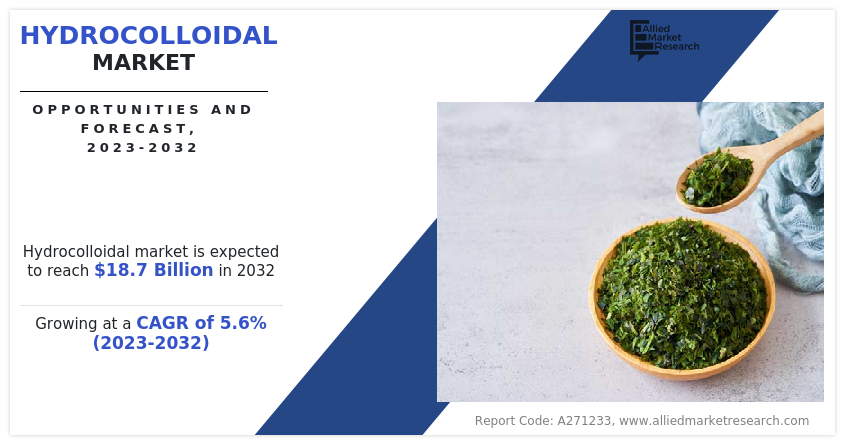
Hydrocolloidal are the substances or materials that have hydrocolloid properties. These substances are widely used in various industries for their unique properties, including their ability to thicken, gel, and stabilize solutions. In medical industry, hydrocolloidal dressings are commonly used for wound care. These dressings often contain hydrocolloid particles that interact with wound exudate, forming a gel that helps create a moist environment around the wound. In the food industry, hydrocolloids are used as thickeners, stabilizers, and gelling agents. These substances contribute to the texture, viscosity, and stability of various food products.
Surge in demand for processed and convenience foods is expected to drive hydrocolloidal market growth during the forecast period.
Rise in demand for processed and convenience foods is a driving force for the incorporation of hydrocolloids in food formulations, contributing to improved product stability, texture, and overall quality. This trend is influenced by change in consumer lifestyles and preferences for convenient food options. However, the fluctuation in raw material prices is expected to act as a major restraint for market growth. Nevertheless, the rise in demand for plant-based and natural ingredients is anticipated to offer many opportunities for market growth in the coming years.
The hydrocolloidal market scope is segmented on the basis of product type, function, end-use industry, and region. By product type, the market is bifurcated into seaweed and others. By function, the market is categorized into thickening agent, gelling agent, stabilizing agent, and others. By end-use industry, the hydrocolloidal market is classified into food & beverage, pharmaceutical, cosmetics, and others. By region, the hydrocolloidal market share is analyzed across North America, Europe, Asia-Pacific, and LAMEA.
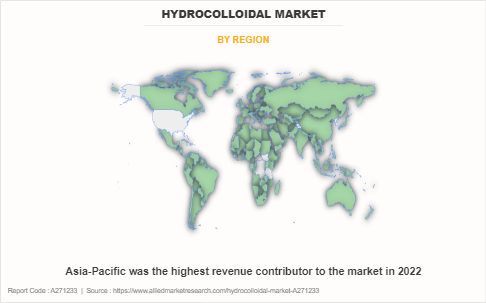
Asia-Pacific was the highest revenue contributor to the market in 2022, accounting for more than half of the global market revenue. The expanding middle class creates a substantial market for food and beverage products in Asia-Pacific. Hydrocolloids play a role in meeting the demand for processed and convenience foods in this populous region. In addition to convenience foods, there is a continued demand for traditional and functional foods in Asia-Pacific. Hydrocolloids are used to improve the texture and stability of these products.
Further, the hydrocolloidal market in Asia-Pacific is competitive, with companies investing in research and development to introduce innovative products and formulations. Local and international players are working to capture opportunities arising from changing consumer preferences.
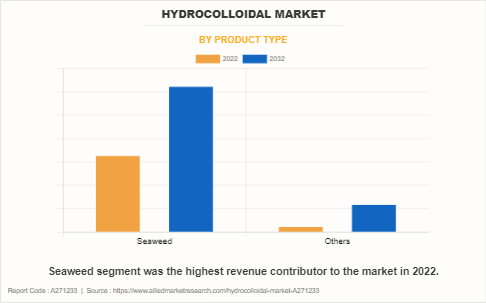
Seaweed segment was the highest revenue contributor to the market in 2022, growing with CAGR of 5.5%. The demand for seaweed-based hydrocolloids has witnessed a notable growth in recent years, due to factors that highlight both the versatility and sustainability of these marine-derived substances. The escalating global awareness of the environmental impact of traditional land-based agriculture has spurred interest in alternative, eco-friendly resources.
Seaweed, as a renewable marine resource, is cultivated in aquatic environments without the need for freshwater, pesticides, or fertilizers, making it an attractive option for environmentally conscious consumers and industries. This aligns with the growing trend toward sustainable and responsibly sourced ingredients in various sectors. In the food industry, for instance, seaweed-based hydrocolloids contribute to enhanced texture, viscosity, and mouthfeel in various products, catering to the evolving preferences of consumers for healthier and more natural ingredients.
Moreover, ongoing research has unveiled the nutritional benefits of seaweed, adding to its appeal. Furthermore, the expanding market for plant-based and vegan products has driven the demand for seaweed-based alternatives in lieu of animal-derived hydrocolloids. This shift reflects a broader societal movement toward plant-centric lifestyles, where seaweed emerges as a viable and sustainable option.
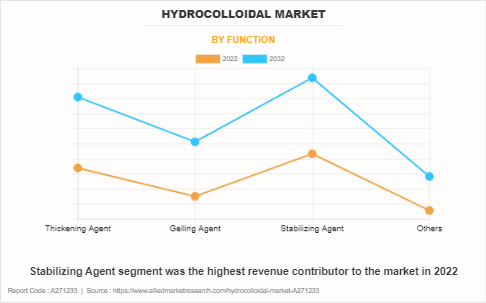
Stabilizing Agent segment was the highest revenue contributor to the market in 2022, growing with CAGR of 5.4%. A stabilizing agent is a substance that enhances the stability of a system by preventing or minimizing undesirable changes, such as separation or aggregation. Hydrocolloidal stabilizing agents are those that utilize hydrophilic colloids, such as gums and proteins, to stabilize various products. Hydrocolloids possess water-attracting properties, allowing them to form a protective network around particles or droplets in a dispersion. This network impedes coalescence or settling, thus enhancing the stability of emulsions, suspensions, and foams.
The demand for stabilizing agents has witnessed a notable surge in recent years, driven by a confluence of factors across various industries. One key driver is the increasing complexity and diversity of products in the food and pharmaceutical sectors. As these industries continue to innovate and expand their product lines, the need for stabilizing agents becomes critical to maintaining product quality, texture, and shelf life. Stabilizing agents play a pivotal role in preventing ingredient separation, texture degradation, and microbial spoilage, ensuring that products reach consumers in optimal condition.
Moreover, the growing awareness and emphasis on clean-label and natural products have contributed to the rising demand for stabilizing agents derived from natural sources. Consumers are increasingly seeking products with fewer synthetic additives, and manufacturers are responding by incorporating stabilizing agents such as pectin, agar-agar, and guar gum, which are perceived as more natural alternatives. This shift in consumer preferences has prompted the food and pharmaceutical industries to invest in R&D to discover and incorporate novel stabilizing agents that meet both functional and clean-label criteria.
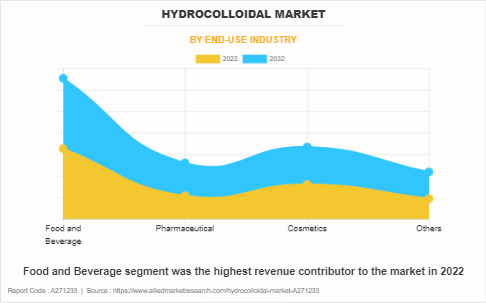
Food and Beverage segment was the highest revenue contributor to the market in 2022, growing with CAGR of 5.9%. Hydrocolloids play a crucial role in the food and beverage industry, serving various functions to enhance product quality. These water-soluble polymers, such as agar, pectin, and carrageenan, act as stabilizers, thickeners, gelling agents, and emulsifiers. In dairy products, hydrocolloids prevent syneresis and improve texture, while in sauces and dressings, they ensure proper viscosity and stability.
In addition, they contribute to the mouthfeel of beverages, providing a desirable texture. Hydrocolloids are instrumental in creating gels for confectionery and improving the shelf life of baked goods. Their versatility makes them indispensable in achieving the desired texture, consistency, and sensory attributes in a wide range of food and beverage applications.
Key players in the hydrocolloidal industry include Ashland Inc., Cargill, Incorporated, Kerry Group plc., BASF SE, Jungbunzlauer Suisse AG, Koninklijke DSM N.V., Glanbia Nutritionals, Inc., Palsgaard, DuPont, and Archer Daniels Midland Company.
Key Benefits For Stakeholders
- This report provides a quantitative analysis of the market segments, current trends, estimations, and dynamics of the hydrocolloidal market analysis from 2022 to 2032 to identify the prevailing hydrocolloidal market opportunities.
- The market research is offered along with information related to key drivers, restraints, and opportunities.
- Porter's five forces analysis highlights the potency of buyers and suppliers to enable stakeholders make profit-oriented business decisions and strengthen their supplier-buyer network.
- In-depth analysis of the hydrocolloidal market segmentation assists to determine the prevailing market opportunities.
- Major countries in each region are mapped according to their revenue contribution to the global market.
- Market player positioning facilitates benchmarking and provides a clear understanding of the present position of the market players.
- The report includes the analysis of the regional as well as global hydrocolloidal market trends, key players, market segments, application areas, and market growth strategies.
Hydrocolloidal Market Report Highlights
| Aspects | Details |
| Market Size By 2032 | USD 18.7 billion |
| Growth Rate | CAGR of 5.6% |
| Forecast period | 2022 - 2032 |
| Report Pages | 503 |
| By Product Type |
|
| By Function |
|
| By End-use Industry |
|
| By Region |
|
| Key Market Players | Jungbunzlauer Suisse AG, Archer Daniels Midland Company, Koninklijke DSM N.V., DuPont, Kerry Group plc., Glanbia Nutritionals, Inc., Palsgaard, Cargill, Incorporated, BASF SE, Ashland Inc. |
Analyst Review
According to the opinions of various CXOs of leading companies, the hydrocolloidal market is expected to witness increased demand during the forecast period. The shift toward natural and plant-based ingredients among consumers has increased the demand for hydrocolloids derived from natural sources. This aligns with the rise in preference for sustainable and environmentally friendly products. Hydrocolloidal dressings are widely used in the medical field for wound care. The emphasis on advanced wound care solutions and the aging global population are expected to contribute to the growth of the hydrocolloidal market in the coming years.
Moreover, the globalization of food supply chains and the need for extended shelf life and stability in food products have led to the increased use of hydrocolloids for their texturizing, gelling, and stabilizing properties. Besides, compliance with food safety regulations and approvals from regulatory bodies contribute to the market growth. Meeting regulatory standards assures consumers and industry stakeholders of the safety and quality of hydrocolloidal products.
The global hydrocolloidal market size was valued at $10.9 billion in 2022, and is projected to reach $18.7 billion by 2032, growing at a CAGR of 5.6% from 2023 to 2032.
Asia-Pacific is the largest regional market for Hydrocolloidal.
Key players in the hydrocolloidal industry include Ashland Inc., Cargill, Incorporated, Kerry Group plc., BASF SE, Jungbunzlauer Suisse AG, Koninklijke DSM N.V., Glanbia Nutritionals, Inc., Palsgaard, DuPont, and Archer Daniels Midland Company.
Food and beverage is the leading application of Hydrocolloidal Market.
Increase in consumption of processed and convenience foods, including ready-to-eat meals and snacks is the key driver for Hydrocolloidal Market.
Loading Table Of Content...
Loading Research Methodology...


